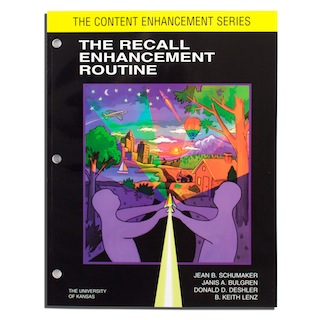
Publication Info: University of Kansas 1998
Recall Enhancement Routine Resources:
VIDEO
PPTs
MORE
- Access Florida SPDG LiveBinder Assets (Key: CE RE)
- Access Content Enhancement Routine Checklists
- Description of the Recall Enhancement Routine from the SIM website
MICROCREDENTIALS
Strategram/Stratenotes
- Strategram Vol. 15, No. 1, October 2002: Recall Enhancement Device Example - Margaret Conrad Nickell
Research
- Recall Enhancement Routine Research slide
- Bulgren, J.A., Deshler, D.D., & Schumaker, J.B. (1997). Use of a recall enhancement routine and strategies in inclusive secondary classes. Learning Disabilities Research & Practice, 12(4), 198-208. A multiple-baseline design study is used with teachers to determine the effects of training on their performance of the Recall Enhancement Routine and a post-test only comparison design is employed to determine the effects of teacher use of the routine on student use of mnemonic devices.
- Bulgren, J.A., Schumaker, J.B., & Deshler, D.D. (1994). The effects of a recall enhancement routine on the test performance of secondary students with and without learning disabilities. Learning Disabilities Research & Practice, 9(1), 2-11. Multiple measures are collected and analyzed using descriptive and inferential statistics to evaluate the effectiveness of repetitious review of the Recall Enhancement Routine on student performance (LD and non-LD) in inclusive general education classrooms.
Assets from FLORIDA SPDG Livebinders:
Teacher can access Florida Live Binder assets. Share this link and password:
https://www.livebinders.com/play/play_shared_binder/2207523?play_view=play Password CE RE
- Cue Do Review
-
The overall instructional process that guides use of the CE device with the Routine’s Linking Steps. This instructional process involves:
Cue: teacher announces the CE routine and explains its use, how it will help students and expectations for student participation
Do: teacher and class collaboratively construct the device using the Linking Steps that “connect” the content to the needs and goals of students
Review: Information presented in the device is reviewed and confirmed, use of the device is reviewed and confirmed, use of the device as a learning and study tool is modeled
- The Routine
- Device Templates
- Device Checklist
- Examples
- FACTOR Cue Card
- Study Card Examples
- Take Turns Cue Cards
